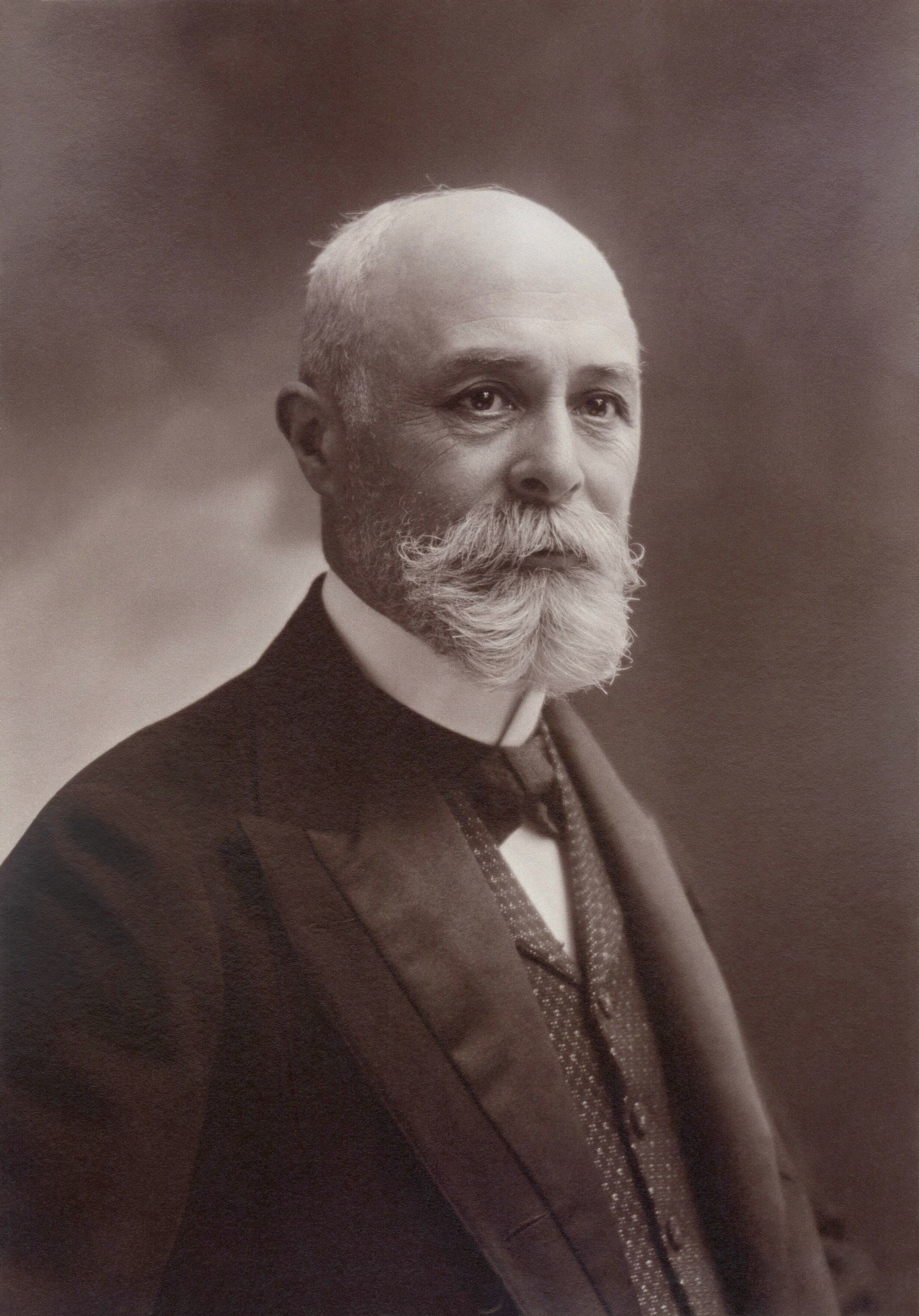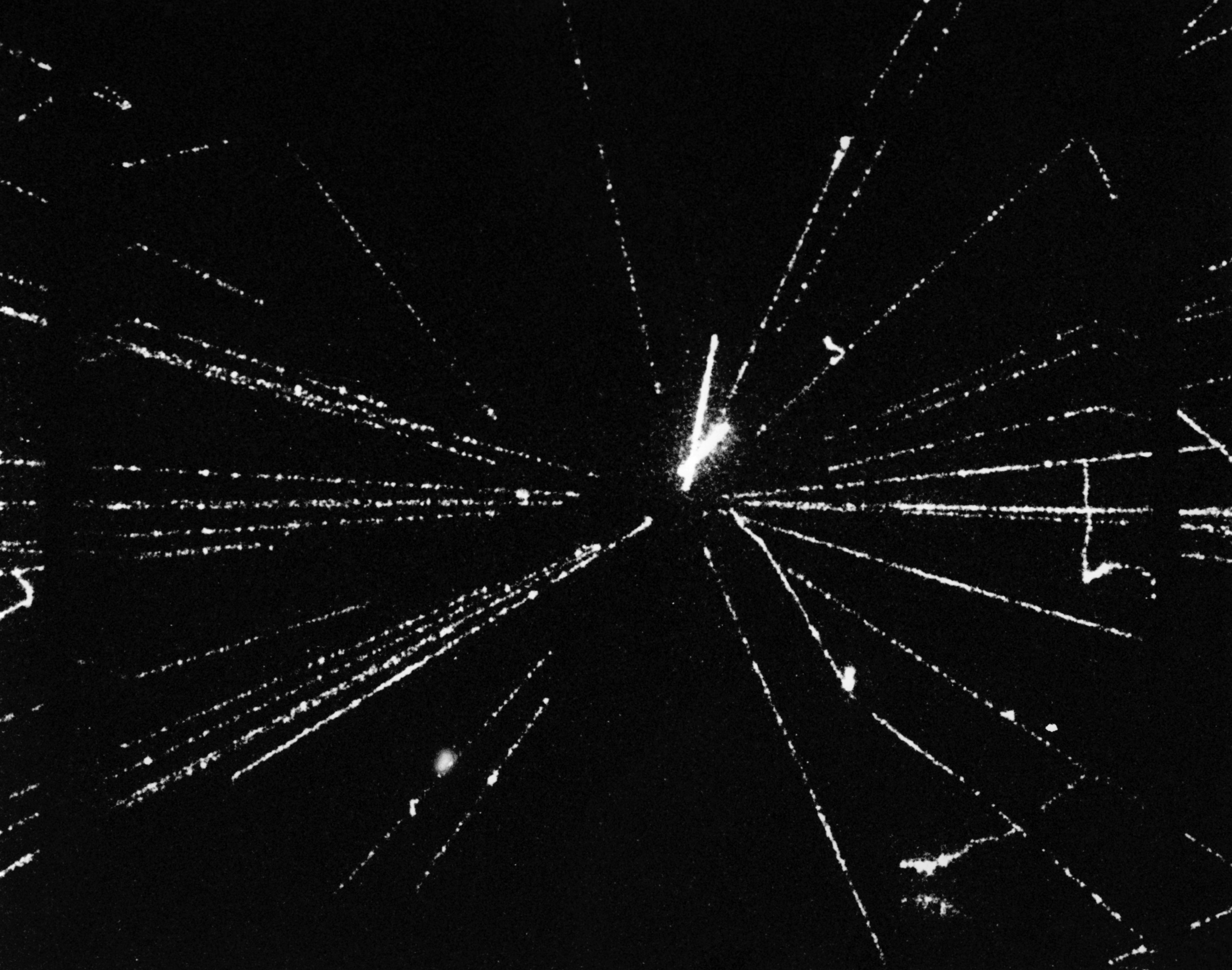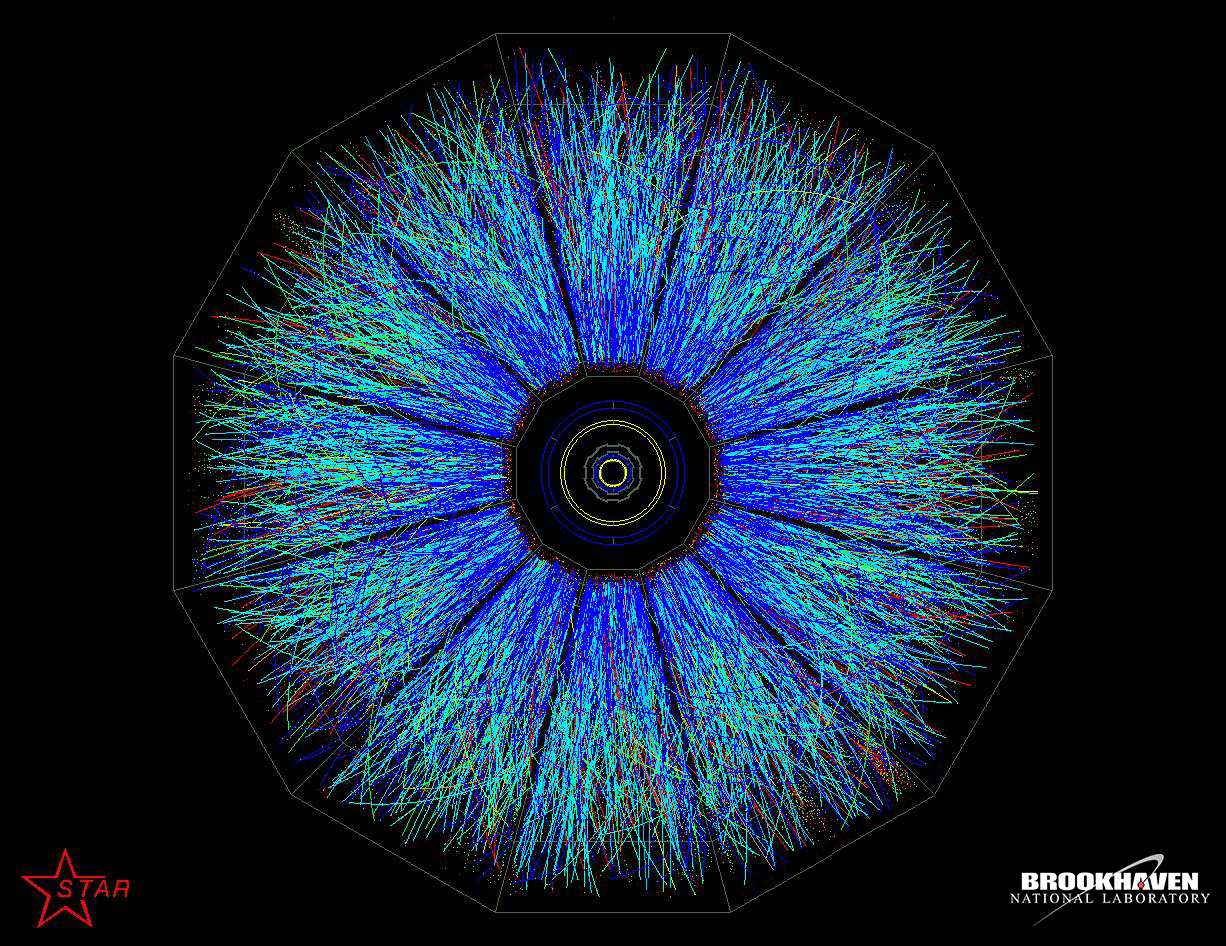|
Hadron Collider
A hadron collider is a very large particle accelerator built to test the predictions of various theories in particle physics, high-energy physics or nuclear physics by colliding hadrons. A hadron collider uses tunnels to accelerate, store, and collide two particle beams. Colliders Only a few hadron colliders have been built. These are: * Intersecting Storage Rings (ISR), European Organization for Nuclear Research (CERN), in operation 1971–1984. * Super Proton Synchrotron (SPS), CERN, used as a hadron collider 1981–1991. * Tevatron, Fermi National Accelerator Laboratory (Fermilab), in operation 1983–2011. * Relativistic Heavy Ion Collider (RHIC), Brookhaven National Laboratory, in operation since 2000. * Large Hadron Collider (LHC), CERN, in operation since 2008. See also *Synchrotron A synchrotron is a particular type of cyclic particle accelerator, descended from the cyclotron, in which the accelerating particle beam travels around a fixed closed-loop path. The mag ... [...More Info...] [...Related Items...] OR: [Wikipedia] [Google] [Baidu] |
Particle Accelerator
A particle accelerator is a machine that uses electromagnetic fields to propel electric charge, charged particles to very high speeds and energies, and to contain them in well-defined particle beam, beams. Large accelerators are used for fundamental research in particle physics. The largest accelerator currently active is the Large Hadron Collider (LHC) near Geneva, Switzerland, operated by the European Organization for Nuclear Research, CERN. It is a collider accelerator, which can accelerate two beams of protons to an energy of 6.5 TeV and cause them to collide head-on, creating center-of-mass energies of 13 TeV. Other powerful accelerators are, Relativistic Heavy Ion Collider, RHIC at Brookhaven National Laboratory in New York and, formerly, the Tevatron at Fermilab, Batavia, Illinois. Accelerators are also used as synchrotron light sources for the study of condensed matter physics. Smaller particle accelerators are used in a wide variety of applications, includ ... [...More Info...] [...Related Items...] OR: [Wikipedia] [Google] [Baidu] |
Particle Physics
Particle physics or high energy physics is the study of fundamental particles and forces that constitute matter and radiation. The fundamental particles in the universe are classified in the Standard Model as fermions (matter particles) and bosons (force-carrying particles). There are three generations of fermions, but ordinary matter is made only from the first fermion generation. The first generation consists of up and down quarks which form protons and neutrons, and electrons and electron neutrinos. The three fundamental interactions known to be mediated by bosons are electromagnetism, the weak interaction, and the strong interaction. Quarks cannot exist on their own but form hadrons. Hadrons that contain an odd number of quarks are called baryons and those that contain an even number are called mesons. Two baryons, the proton and the neutron, make up most of the mass of ordinary matter. Mesons are unstable and the longest-lived last for only a few hundre ... [...More Info...] [...Related Items...] OR: [Wikipedia] [Google] [Baidu] |
High-energy Physics
Particle physics or high energy physics is the study of fundamental particles and forces that constitute matter and radiation. The fundamental particles in the universe are classified in the Standard Model as fermions (matter particles) and bosons (force-carrying particles). There are three generations of fermions, but ordinary matter is made only from the first fermion generation. The first generation consists of up and down quarks which form protons and neutrons, and electrons and electron neutrinos. The three fundamental interactions known to be mediated by bosons are electromagnetism, the weak interaction, and the strong interaction. Quarks cannot exist on their own but form hadrons. Hadrons that contain an odd number of quarks are called baryons and those that contain an even number are called mesons. Two baryons, the proton and the neutron, make up most of the mass of ordinary matter. Mesons are unstable and the longest-lived last for only a few hundredths ... [...More Info...] [...Related Items...] OR: [Wikipedia] [Google] [Baidu] |
Nuclear Physics
Nuclear physics is the field of physics that studies atomic nuclei and their constituents and interactions, in addition to the study of other forms of nuclear matter. Nuclear physics should not be confused with atomic physics, which studies the atom as a whole, including its electrons. Discoveries in nuclear physics have led to applications in many fields. This includes nuclear power, nuclear weapons, nuclear medicine and magnetic resonance imaging, industrial and agricultural isotopes, ion implantation in materials engineering, and radiocarbon dating in geology and archaeology. Such applications are studied in the field of nuclear engineering. Particle physics evolved out of nuclear physics and the two fields are typically taught in close association. Nuclear astrophysics, the application of nuclear physics to astrophysics, is crucial in explaining the inner workings of stars and the origin of the chemical elements. History The history of nuclear physics as a di ... [...More Info...] [...Related Items...] OR: [Wikipedia] [Google] [Baidu] |
Hadrons
In particle physics, a hadron (; grc, ἁδρός, hadrós; "stout, thick") is a composite subatomic particle made of two or more quarks held together by the strong interaction. They are analogous to molecules that are held together by the electric force. Most of the mass of ordinary matter comes from two hadrons: the proton and the neutron, while most of the mass of the protons and neutrons is in turn due to the binding energy of their constituent quarks, due to the strong force. Hadrons are categorized into two broad families: baryons, made of an odd number of quarks (usually three quarks) and mesons, made of an even number of quarks (usually two quarks: one quark and one antiquark). Protons and neutrons (which make the majority of the mass of an atom) are examples of baryons; pions are an example of a meson. "Exotic" hadrons, containing more than three valence quarks, have been discovered in recent years. A tetraquark state (an exotic meson), named the Z(4430), was disc ... [...More Info...] [...Related Items...] OR: [Wikipedia] [Google] [Baidu] |
Particle Beams
A particle beam is a stream of charged or neutral particles. In particle accelerators, these particles can move with a velocity close to the speed of light. There is a difference between the creation and control of charged particle beams and neutral particle beams, as only the first type can be manipulated to a sufficient extent by devices based on electromagnetism. The manipulation and diagnostics of charged particle beams at high kinetic energies using particle accelerators are main topics of accelerator physics. Sources Charged particles such as electrons, positrons, and protons may be separated from their common surrounding. This can be accomplished by e.g. thermionic emission or arc discharge. The following devices are commonly used as sources for particle beams: * Ion source * Cathode ray tube, or more specifically in one of its parts called electron gun. This is also part of traditional television and computer screens. * Photocathodes may also be built in as a part of an ... [...More Info...] [...Related Items...] OR: [Wikipedia] [Google] [Baidu] |
Intersecting Storage Rings
The ISR (standing for "Intersecting Storage Rings") was a particle accelerator at CERN. It was the world's first hadron collider, and ran from 1971 to 1984, with a maximum center of mass energy of 62 GeV. From its initial startup, the collider itself had the capability to produce particles like the J/ψ and the upsilon, as well as observable jet structure; however, the particle detector experiments were not configured to observe events with large momentum transverse to the beamline, leaving these discoveries to be made at other experiments in the mid-1970s. Nevertheless, the construction of the ISR involved many advances in accelerator physics, including the first use of stochastic cooling, and it held the record for luminosity at a hadron collider until surpassed by the Tevatron in 2004. History The ISR was proposed in 1964 for conducting the head-on proton-proton collisions at a beam energy of 28 GeV; to the study of the new particles created in such collisions.&nb ... [...More Info...] [...Related Items...] OR: [Wikipedia] [Google] [Baidu] |
European Organization For Nuclear Research
The European Organization for Nuclear Research, known as CERN (; ; ), is an intergovernmental organization that operates the largest particle physics laboratory in the world. Established in 1954, it is based in a northwestern suburb of Geneva, on the France–Switzerland border. It comprises 23 member states, and Israel (admitted in 2013) is currently the only non-European country holding full membership. CERN is an official United Nations General Assembly observer. The acronym CERN is also used to refer to the laboratory; in 2019, it had 2,660 scientific, technical, and administrative staff members, and hosted about 12,400 users from institutions in more than 70 countries. In 2016, CERN generated 49 petabytes of data. CERN's main function is to provide the particle accelerators and other infrastructure needed for high-energy physics research — consequently, numerous experiments have been constructed at CERN through international collaborations. CERN is the site o ... [...More Info...] [...Related Items...] OR: [Wikipedia] [Google] [Baidu] |
Super Proton Synchrotron
The Super Proton Synchrotron (SPS) is a particle accelerator of the synchrotron type at CERN. It is housed in a circular tunnel, in circumference, straddling the border of France and Switzerland near Geneva, Switzerland. History The SPS was designed by a team led by John Adams, director-general of what was then known as Laboratory II. Originally specified as a 300 GeV accelerator, the SPS was actually built to be capable of 400 GeV, an operating energy it achieved on the official commissioning date of 17 June 1976. However, by that time, this energy had been exceeded by Fermilab, which reached an energy of 500 GeV on 14 May of that year. The SPS has been used to accelerate protons and antiprotons, electrons and positrons (for use as the injector for the Large Electron–Positron Collider (LEP)), and heavy ions. From 1981 to 1991, the SPS operated as a hadron (more precisely, proton–antiproton) collider (as such it was called SpS), when its beams provided the d ... [...More Info...] [...Related Items...] OR: [Wikipedia] [Google] [Baidu] |
Tevatron
The Tevatron was a circular particle accelerator (active until 2011) in the United States, at the Fermi National Accelerator Laboratory (also known as ''Fermilab''), east of Batavia, Illinois, and is the second highest energy particle collider ever built, after the Large Hadron Collider (LHC) of the European Organization for Nuclear Research (CERN) near Geneva, Switzerland. The Tevatron was a synchrotron that accelerated protons and antiprotons in a ring to energies of up to 1 TeV, hence its name. The Tevatron was completed in 1983 at a cost of $120 million and significant upgrade investments were made during its active years of 1983–2011. The main achievement of the Tevatron was the discovery in 1995 of the top quark—the last fundamental fermion predicted by the Standard Model of particle physics. On July 2, 2012, scientists of the CDF and DØ collider experiment teams at Fermilab announced the findings from the analysis of around 500 trillion collisions produced from ... [...More Info...] [...Related Items...] OR: [Wikipedia] [Google] [Baidu] |
Fermi National Accelerator Laboratory
Fermi National Accelerator Laboratory (Fermilab), located just outside Batavia, Illinois, near Chicago, is a United States Department of Energy national laboratory specializing in high-energy particle physics. Since 2007, Fermilab has been operated by the Fermi Research Alliance, a joint venture of the University of Chicago, and the Universities Research Association (URA). Fermilab is a part of the Illinois Technology and Research Corridor. Fermilab's Main Injector, two miles (3.3 km) in circumference, is the laboratory's most powerful particle accelerator. The accelerator complex that feeds the Main Injector is under upgrade, and construction of the first building for the new PIP-II linear accelerator began in 2020. Until 2011, Fermilab was the home of the 6.28 km (3.90 mi) circumference Tevatron accelerator. The ring-shaped tunnels of the Tevatron and the Main Injector are visible from the air and by satellite. Fermilab aims to become a world center in neut ... [...More Info...] [...Related Items...] OR: [Wikipedia] [Google] [Baidu] |
Relativistic Heavy Ion Collider
The Relativistic Heavy Ion Collider (RHIC ) is the first and one of only two operating heavy- ion colliders, and the only spin-polarized proton collider ever built. Located at Brookhaven National Laboratory (BNL) in Upton, New York, and used by an international team of researchers, it is the only operating particle collider in the US. By using RHIC to collide ions traveling at relativistic speeds, physicists study the primordial form of matter that existed in the universe shortly after the Big Bang. By colliding spin-polarized protons, the spin structure of the proton is explored. RHIC is as of 2019 the second-highest-energy heavy-ion collider in the world. As of November 7, 2010, the Large Hadron Collider (LHC) has collided heavy ions of lead at higher energies than RHIC. The LHC operating time for ions (lead–lead and lead–proton collisions) is limited to about one month per year. In 2010, RHIC physicists published results of temperature measurements from earlier exp ... [...More Info...] [...Related Items...] OR: [Wikipedia] [Google] [Baidu] |






